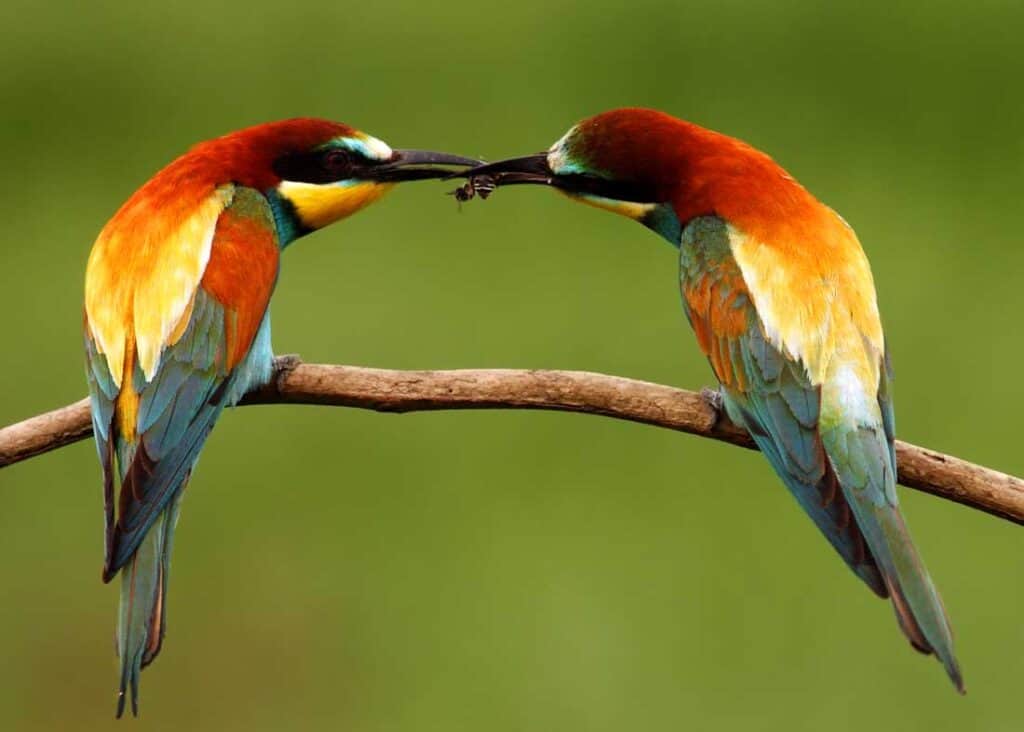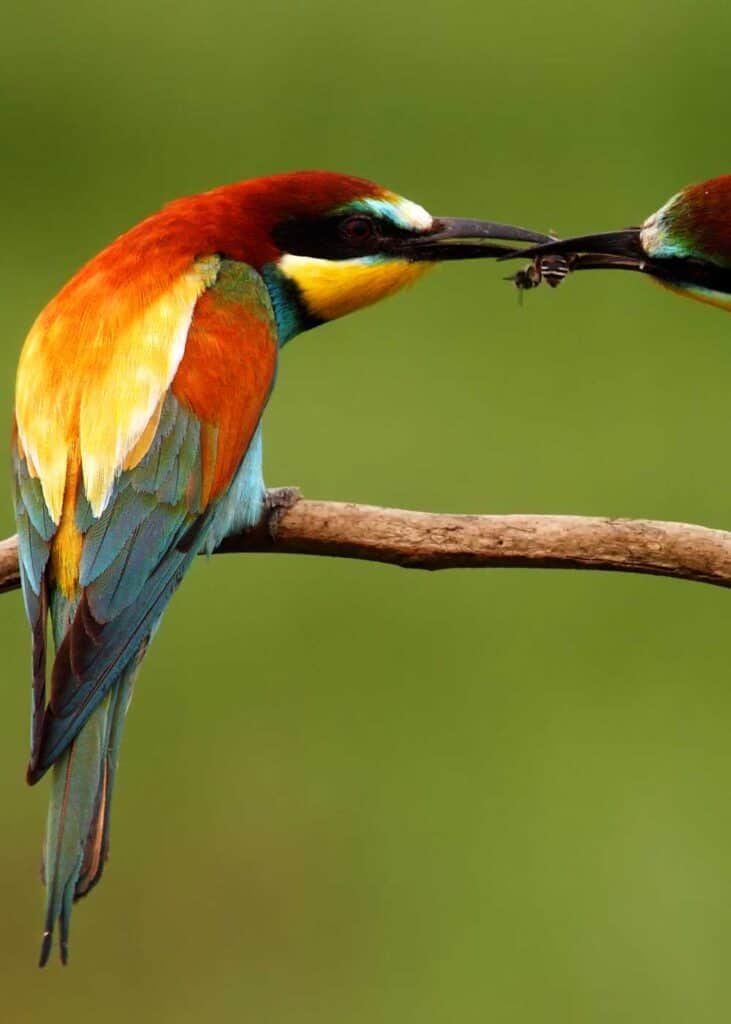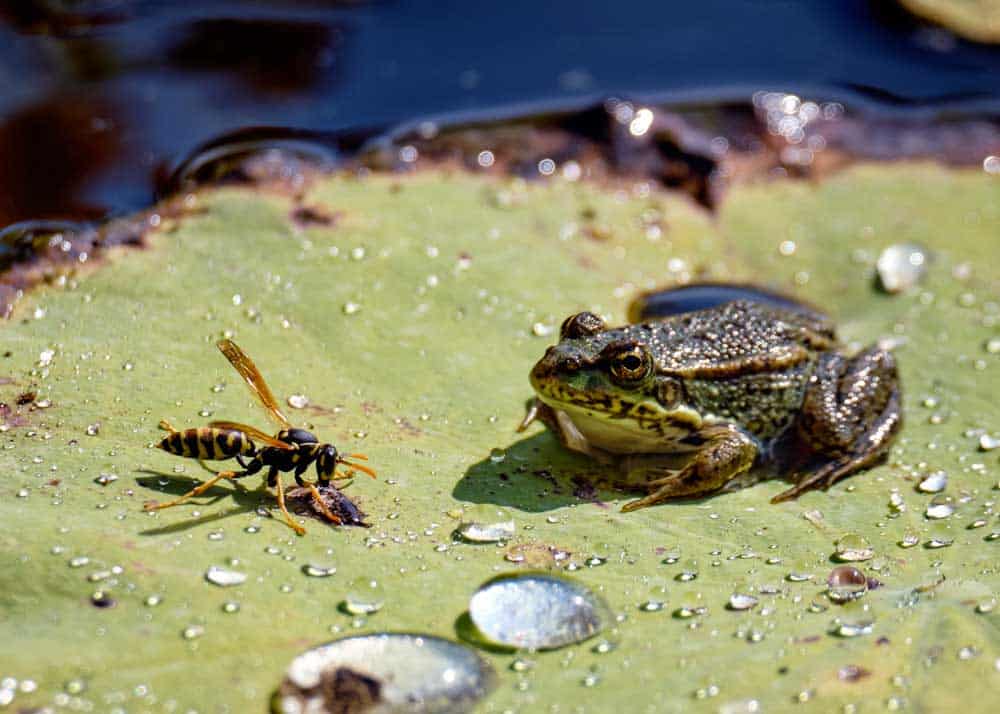Wasps are aggressive predators and scavengers. Curious what eats them? Here’s our guide to what eats wasps. You’ll learn about animals, including insects, birds, and mammals that are wasp predators.
Animals from every class will eat a wasp. Insects and birds are especially adept at hunting and eating wasps. But mammals, amphibians, and reptiles also eat wasps. Humans from Japan to Mexico commonly eat wasps and their larvae. Here’s the guide to what eats wasps.

In this post, you’ll learn what eats wasps. Though wasps do not have as many natural predators as other creatures do, both birds and other insects will eat them. The creatures that eat wasps also include some amphibians and reptiles.
Table of Contents
Natural Predators of Wasps
9 Insects that Eat Wasps
Many of the creatures that eat wasps are other insects.
Bald-faced hornets are a member of the wasp family but often prey on their cousins.
European hornets will also occasionally eat wasps.
Robber or assassin flies are unique because they will fly through the air and snatch a wasp in the middle of the air. The fly then gives them toxic venom before eating them.
Here are 9 insects and spiders that will eat wasps.
- Hoverflies
- Centipedes
- Robber flies
- Beetles
- Bald-faced hornets
- Moths
- Praying mantis
- Yellow garden spider
- Orb-weaver spider
While dragonflies and caterpillars occasionally eat wasps, they prefer larvae to adult wasps. The bright colors found on the wasps often attract those insects.
Some types of spiders also eat wasps. Garden spiders and others that spin webs use their webs to gather food. When a wasp lands on the silk, it becomes stuck and cannot move.
Other spiders are hunters that will grab a wasp and bite it. Their bite contains venom that stuns and immobilizes the wasp to keep it from fighting or moving as the wasp feeds. Learn more about wolf spiders.
15 Birds that Eat Wasps
Do birds eat wasps? Absolutely. Wasps are easy prey for these birds that specialize in hunting them.
Most birds eat a varied diet that includes both plants and insects.
There are more than 20 types of birds that commonly eat wasps.
Though some seek them out in their homes and use different methods to trick the wasps to come out, others dine on those they find in the wild.
Sparrows, wrens, warblers, and magpies are just a few of the birds that eat wasps.
- Swallows
- Bee-eaters
- Warblers
- Orioles
- Bluebirds
- Sparrows
- Chickadees
- Cardinals
- Tanagers
- Starlings
- Honeyeaters
- Magpies
- Purple Martins
- Mockingbirds
- Blackbirds
Learn more about other birds that eat wasps.

Unlike other creatures that will eat dozens of wasps, birds look for solitary or individual wasps.
They move so quickly that the wasps cannot defend themselves.
Bee birds use a different hunting method in which they snatch a wasp and beat the bug against a hard surface until its venom is no longer a threat.
As male wasps lack stingers, bee birds will simply swallow them whole.
There are also honey buzzards that have feathers around their faces that are thick and heavy. Their feathers confuse wasps and keep them from seeing the birds as threats.
6 Amphibians and Reptiles that Eat Wasps
Both amphibians and reptiles prey on wasps.
Asian geckos primarily eat a type of large wasp called Polistes. As this wasp has a sting that can kill some animals, this gecko is one of the only types that can eat it.
Frogs and toads eat any insects that come into their habitats and eat various types of wasps.
Salamanders will also eat wasps as well as their larvae.
Here are some reptiles and amphibians that eat wasps:
- Asian geckos
- Frogs
- Toads
- Indiana northern dusky salamander
- Turtles
- Lizards

6 Mammals That Eat Wasps
Though you may not think that mammals can survive on bugs, several types eat adult wasps and larvae.
Black bears attack the colonies where the bugs live and force them to come out. While the bears eat any flying wasps that come close to them and those that try to sting them, they mainly go after the larvae inside the colony as it provides a good source of protein.
Badgers also eat wasps and consume those found in the ground and those above ground. A badger can use its strong claws to reach deep below the ground and scoop out the larvae.
Here are some mammals that will eat wasps:
- Badgers
- Black bears
- Weasels
- Mice
- Stoats
- Some bats will also eat wasps. Do bats eat bees?
Want to keep wasps away? Here are 17 essential oils that repel wasps.
Do Humans Eat Wasps?
Humans do eat wasps, especially in Japan where growers keep colonies. The country even has a wasp festival where people eat them as a delicacy.
Most claim that wasps have a meaty flavor that is similar to shrimp. Many people prefer eating the larvae rather than adult wasps because they have more protein and are easier to consume.
You should not eat wasps that you find in your yard though because you have no way of knowing if they came into contact with toxic chemicals.
Humans also eat wasps in Mexico. The Mexican honey wasp provides a delicacy (honey and larva) in some indigenous communities.
Learn about what eats hornets.
How Do Wasps Protect Themselves?
While there are different types of wasps, they all have stingers that they use to protect themselves. When a predator attacks, the wasp inserts its stinger.
When a bee stings you, it loses its stinger in your skin and slowly dies. Wasps are different because they do not lose their stingers. One wasp can sting you 10 or more times and keep stinging you until the insect no longer views you as a threat.
Another thing to keep in mind is that wasps can sting as part of a group. This often happens if you stumble across a colony. All of the wasps will keep stinging you and may even follow you for several minutes.
Social wasps live in groups and produce pheromones when they sense danger. The pheromones let the other wasps know that a predator is nearby and tell them to get ready.
Wasps are also smart in how they build their nests. Though some types stick to the ground, most build their nests in places that are hard for predators to reach such as gutters, eaves, and treetops.
Those that live underground often use hard mud, which allows them to place a protective barrier to keep their larvae safe.
A famous type of wasp is the ground hornet.
More reading: Bee vs Wasp vs Hornet (Identification Guide)
Wasps as a Food Source
When looking at what eats wasps, you’ll find that they have natural predators that include some types of reptiles and amphibians. Both birds and other insects eat these bugs as do some types of mammals such as badgers.
In some places, humans also have a fondness for wasps and eat both wasp larvae and honey as a delicacy.
- About the Author
- Latest Posts
Bryan Haines is a co-founder and writer at The Buginator. And is working to make it the best resource for taking back the outdoors from biting, stinging pests.
He also blogs about travel at Storyteller.Travel and photography at Storyteller Tech. Bryan is a partner at Storyteller Media, a publishing company he runs with his wife, Dena.

Robert McBride
Thursday 17th of August 2023
Something is digging and eating, I think, ground wasps in ground and the paper balls on the ground. Live just north of flint, MI. Any ideas?